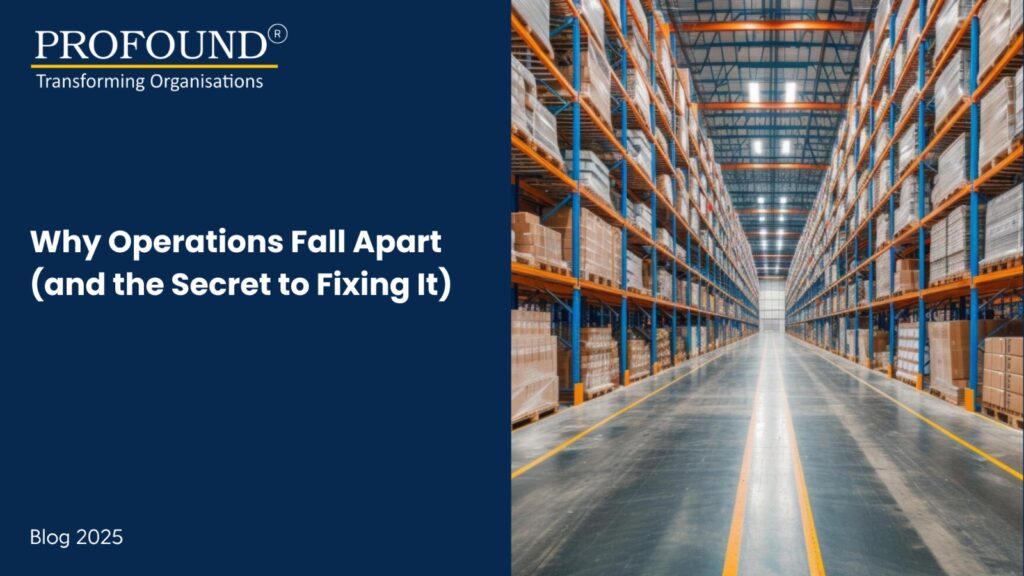
“Cut waste, boost efficiency.”
It’s a rallying cry you’ll hear in every boardroom. Lean, efficient operations are supposed to be the gold standard of good business. But here’s the hidden truth:
Efficiency without resilience isn’t excellence—it’s fragility.
At Profound Consulting, we’ve worked with businesses across industries who were doing all the “right” things. They trimmed their workforce, maximized machine utilization, and cut inventory to near-zero—all in the name of efficiency. But when the unexpected hit—and it always does—they found themselves firefighting, missing deadlines, and losing customers.
In this blog, we’ll explore why buffer design is the missing link in most operational strategies and how building the right kind of slack can dramatically improve profitability, performance, and peace of mind.
Awareness: The Efficiency Trap Most Companies Fall Into
Let’s start with what feels familiar.
You plan meticulously.
You forecast demand.
You optimize schedules.
You invest in automation.
Still, you’re left with:
- Delayed deliveries
- Stretched teams
- Customer complaints
- High operating stress
Why? Because your operations are running at (or dangerously close to) full utilization—leaving no room to recover when things go wrong.
This is what we call the efficiency trap.
It looks good on spreadsheets but collapses under real-world variability:
- A supplier misses delivery
- A key team member takes leave
- A customer places an urgent high-volume order
- A machine breaks down mid-cycle
When there’s no buffer, even a small disruption can derail your entire system.
Comprehension: Why Buffers Are a Business Necessity—Not a Luxury
In a perfect world, lean works. In the real world, variability is constant.
What most businesses overlook is that variability in demand, supply, and capacity is not an exception—it’s the norm.
Here’s what happens when you eliminate buffers entirely:
Non-linear increase in Wait Times
Once utilization crosses ~80-85%, wait times and delays grow non-linearly.
What seems like a “small” push to 90%+ efficiency leads to bottlenecks, rework, and breakdowns.
Team Burnout
Pushing staff and machines to their limit might look efficient, but it creates burnout, errors, and turnover. The system appears stable—until it isn’t.
Customer Dissatisfaction
When delivery timelines slip or service is inconsistent, your brand takes the hit. One late delivery undoes months of relationship-building.
Now, let’s flip the script.
Buffers—when used intentionally and strategically—aren’t about waste.
They’re about building breathing room into your operations so your team can perform better, your customers get consistent results, and your systems can adapt instead of collapse.
Conviction: Global Companies That “Lose” Efficiency to Win in the Long Run
Let’s look at companies that deliberately design slack into their operations—and win because of it.
✅ Toyota – The Gold Standard of “Lean” That Isn’t Lean Everywhere
Toyota famously ran only two shifts, even when it had the demand for three.
Why? The third shift acted as protective capacity, used only when production fell behind or orders surged.
That “inefficient” buffer is exactly what allowed them to deliver consistently, maintain quality, and scale globally—without chaos.
✅ Amazon – Masters of “Just-in-Time”… and Just-in-Case
Amazon is often associated with just-in-time logistics. But what makes them truly resilient is their use of inventory and time buffers:
- Stock is pre-positioned near customer hubs, creating inventory redundancy & creating aggregation benefit.
- Delivery estimates include time buffers, so the company under-promises and over delivers.
It’s not that Amazon is an absolute system—it’s that their system is strategically buffered for when things go wrong.
✅ Action: How to Build Buffers That Drive Profitability and Sustainable Growth
You don’t need to over-invest or slow down to build buffers.
You need to be strategic.
Here’s how Profound Consulting helps companies transform their operations through intelligent buffer design:
Step 1: Identify Critical Chokepoints
Start by mapping your current operational flow.
- Where do delays or bottlenecks happen most?
- Which machines, departments, or teams are always under pressure?
- Where does customer dissatisfaction stem from?
These are your high-leverage zones—where buffers can make the biggest impact.
Step 2: Quantify Variability
Gather operational insights to understand:
- Demand fluctuations (by day/week/month)
- Machine downtime history
- Employee absenteeism
- Supplier reliability metrics
- Que time
This step turns intuition into intelligence—and helps you justify buffer investment to stakeholders.
Step 3: Design the Right Buffers
Not all buffers are created equal. At Profound Consulting, we help you design buffers:
Capacity Buffers
Leave 10–15% spare machine time or manpower in key processes whether it’s a manufacturing or a software development system.
Protective capacity allows you to catch up quickly without disruption & help grow non-linearly.
Inventory Buffers
Strategically stock materials, semi-finished goods or finished goods where delays are most likely.
This prevents upstream hiccups from paralyzing downstream processes.
Time Buffers
Add extra time to planning, delivery promises, or scheduling.
It helps you under-promise and over-deliver—building customer loyalty.
Step 4: Monitor, Adjust, Optimize
Buffers aren’t a one-time fix. They are dynamic & they must evolve with your business.
We help you set up real-time dashboards and KPIs to track:
- Buffer usage trends
- Service level improvements
- Throughput & Cost benefit ratios
- Lead time reduction metrics
This feedback loop lets you scale with confidence—knowing your operations are both lean and resilient.
Case in Point: When a Mid-Sized Industrial & Automotive products manufacturing Company Added Buffers
One of our clients—a growing industrial & automotive products manufacturing company—faced increasing demand but kept missing delivery targets.
They had:
- Machines running at 80%+ effectiveness
- Zero inventory buffers
- Unrealistic delivery promises
We helped them design:
- Inventory buffer at their bottleneck station
- Capacity buffer in their non-bottleneck processes
- A Time based buffer for their Made to Order products
Within 90 days:
- On-time delivery went from 62% to 96%
- Urgent shipments dropped by 80%
- Team satisfaction improved significantly
And all without adding a single new machine or manpower.
Final Takeaway: Don’t Just Build Efficient Operations. Build Resilient Ones.
Lean isn’t wrong. But when you strip away every ounce of slack, you leave your operations exposed.
At Profound Consulting, with our Business solutions consulting, we help businesses find the right balance between efficiency and resilience through flow-based strategies, diagnostics, and capacity improvement strategies.
Because real operational excellence isn’t about doing more with less.
It’s about doing more without breaking when the unexpected hits.
Ready to Build a Smarter, More Resilient Operation?
Let’s reimagine your operations with buffers that breathe—designed to scale without chaos.
📞 Book a strategy session with Profound Consulting
Explore our tailored solutions in business diagnostics, throughput, profitability optimization consulting , and sustainable business solutions—because growth should be consistent, not chaotic.



